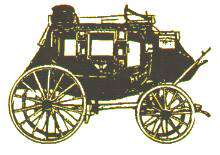Cannonball Stageline Highway
category : Landmarks
 Donald R. Green was originally from Kentucky but learned to ride a stage coach while living in Montana. Hearing about how people were moving westward through Kansas during the late 1800s beyond where the railroads ended, he saw a financial opportunity.
Donald R. Green was originally from Kentucky but learned to ride a stage coach while living in Montana. Hearing about how people were moving westward through Kansas during the late 1800s beyond where the railroads ended, he saw a financial opportunity.Beginning in Kingman, west of Wichita, he soon had a reputation for moving people faster than any other stageline. Remembering the legend of the Wabash Cannonball trail and comparing the speed of his stages to it, Green named the stageline "The Cannonball" and claimed that even Father Time could not keep up with him. Using two teams of horses, he had relay stations every ten to fifteen miles, thus being able to travel faster than his competition.
His stageline first went from Kingman to Coldwater, a 100-mile trip. This trip would include Pratt, west of Kingman, and the round trip could be made in 2 days. Ever looking for new opportunities, Green teamed with other men to found the city of Greensburg.
Green was elected to represent Greensburg and Kiowa County in the state legislature. It was during this time that the nickname "Cannonball" was tagged on him.
As the railroads caught up with him, Green would move further west and in 1889 he made an agreement with the Chicago, Kansas and Nebraska Railroad to take passengers to the unassigned land in Indian Territory. This was to be the salvation of his by then foundering company, but it turned into the downfall instead as the railroad did not let him know in time that nearly all the passengers would arrive on one train and he could not possibly take care of them all. His reputation suffered immensely.
In 1893 he made the run into the Cherokee Strip and staked a claim northwest of Pond Creek. Never as successful at farming as he had been as a stage coach driver, he lost his great financial status, but never his flamboyancy and determination.
D.R. "Cannonball" died in 1922 at the age of 85 years in Long Beach, California.
When Woody Hockaday began marking major roads, he followed the former Cannonball Stage route. In later years, this route became U.S. Highway 54.
- Researched speech presented to the State of Kansas Transportation Committees to acquire the official designation of Highway 54 between Kingman and Greensburg as the Cannonball Stageline Highway.
Come visit us in Kingman, Kansas